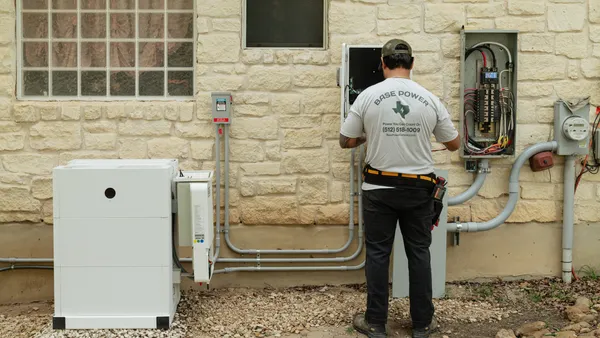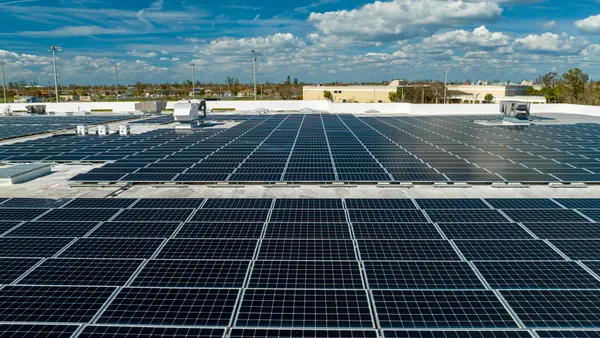Google's $3.2 billion acquisition of smart home startup Nest was the search-engine giant's most visible foray into the energy space, but it was far from the first. Google has invested over $1 billion in renewable power plants over years and appears poised to be a major player in the energy sector for years to come.
Let's take a closer look at Google's strategy and whether it is, in fact, becoming an energy company:
A brief history of Google, an energy company
With its power-sucking data centers, Google is one of the world's single largest energy consumers. In 2011, the company consumed 2.7 million megawatt-hours of electricity—roughly the equivalent consumption of Austin, Texas. While this may be why Google started to invest in energy—as a means to offset its use—the company has since broadened its scope.
Here's the lowdown: Google has invested over $1 billion in over 2 GW of wind and solar power plants, without taking into account the numerous power purchase agreements it has entered into in an effort to offset emissions from its data centers.
"Slowly but surely, Google has become a major player in U.S. solar project finance, and one of the few corporate investors to have made significant, repeated investments in solar projects and portfolios. Google is likely also the only corporate investor outside the energy sector to have played in both the utility-scale market and the distributed generation market," Shayle Kann, vice president of GTM Research, said following Google's announcement in November that it would invest $80 million in six solar power plants.
Before the Nest acquisition, Google was already viewed as an emerging force in the energy space. After the deal hit headlines, it was another story.
The once and future energy company?
In the energy value chain of the last 100 years, power traveled one way only.
"Generators make the power in power plants, high-voltage lines transmit the power to substations in your neighborhood, and the small wires and equipment on the poles leading to your home or office are the distribution system," Peter Fox-Penner writes in "Smart Power: Climate Change, the Smart Grid, and the Future of Electric Utilities."
The entire traditional electricity value chain takes place behind the meter. Consumers largely interact with their utility when they turn their lights on and when they open their utility bill. Consumers typically have little-to-no awareness of how they get their energy. For many years, the prevailing line of thought was that the less the customer thinks about the utility, the better.
But that's changing. Information technology and distributed energy resources are disrupting the traditional one-way energy value chain—and bringing energy out from behind the meter.
As the shift to a decentralized grid takes hold, it's possible that the companies that manage consumers' interaction with the power grid and vice-versa will become the energy companies of the future.
When asked who NRG Energy’s competitors will be in the future, CEO David Crane put it rather subtly: "If you ask me who I worry about beating us, I give very little thought to the traditional power companies, the utilities."
"One of the changes we’re talking about when you’re talking about balancing everyone’s power systems in their house is that it basically becomes an information technology-based industry," Crane explained to The Atlantic. "Of the big four companies that will inherit the Earth—Facebook, Google, Apple, and Amazon—the one that has shown the most interest in this space is Google."
Google aims to empower consumers with control of their energy use, which can then be leveraged to provide power and information back to the grid. Individually, that value is minimal; collectively, it is powerful.
Back in 2008, Google CEO Eric Schmidt said he "could imagine a smart garage where I would plug in my car and the computer handles it. I could even make money by cost shifting."
"It sure sounds to me like a problem for the Internet and personal computers," he added. "It's the largest opportunity I could possibly imagine."
With its big data kung-fu and seemingly endless reserves of capital, Google appears perfectly positioned to sell energy as a service to consumers. All the signs are there: Nest's smart home hardware, EnergySense's energy management software, and Android's customer-facing touch point for the home.
In the race for the smart home alone, Google's $3.2 billion investment says a lot. It's not too crazy to think the commercialization of energy is next.
What Google means for utilities
Google's entry into the energy business exposes the ongoing shift in the electric utility sector.
Utilities face key questions as to whether and how they want to evolve their business models moving forward. There are two distinct approaches, as well as some in between.
There's the Smart Integrator utility model. Essentially, the Smart Integrator utility is the regulated operator of the electric transmission and distribution systems only, with strong regulatory incentives for energy efficiency.
Here's a slide drawn up by Peter-Fox Penner of the Brattle Group:
The Smart Integrator model is not much of a growth opportunity for utilities. This would be a stable, if static, role.
On the other hand, there's the Energy Service model.
Like the Smart Integrator, this type of utility would play the role of transmission and distribution network operator. But in this scenario, the utility's mission would be to provide the lowest cost (or high quality) energy services such as rooftop solar systems and energy efficiency platforms.
Here is another slide from Fox-Penner:
But the Energy Service model is not without its pitfalls. New business models are inherently risky, and utilities are typically risk-averse, slow-moving entities. The Energy Service model is not a natural fit for today's electric utilities, but it does represent the greatest growth opportunities.
Following the Google-Nest news, I spoke to Adrian Tuck, CEO of energy management software startup Tendril. “I think utilities have to make a choice. There’s really two paths they can go: this constant stick to my path of continuing do the very real and hard work of managing generation, transmission and distribution," he said. "The other path is: lean in and make a play to build a customer-centric business that’s going to in some cases partner, in other cases compete with people who are going after the home energy space."
Utilities "cannot treat this as an isolated incident. This is one of a number of significant syndicates that will form and are going after some combination of the home and energy," Tuck observed. "Last-mile telco companies," for example, and solar companies "with ambitions to become a new kind of utility" are just some of the players vying for opportunities in this emerging space.
Whether or not Google succeeds in bringing energy out from behind the meter, the commercialization of energy is a big opportunity. Some utilities will remain in the reliable operator role; others will adapt to the new landscape and generate new business models to capitalize on it. Without question, the power sector is undergoing radical transformation. Google is just one of the first and biggest to plant its multi-billion dollar flag, and it is doing so at the intersection of the power grid, the consumer and the Internet. It's up to utilities to decide whether that's a threat or an opportunity.














